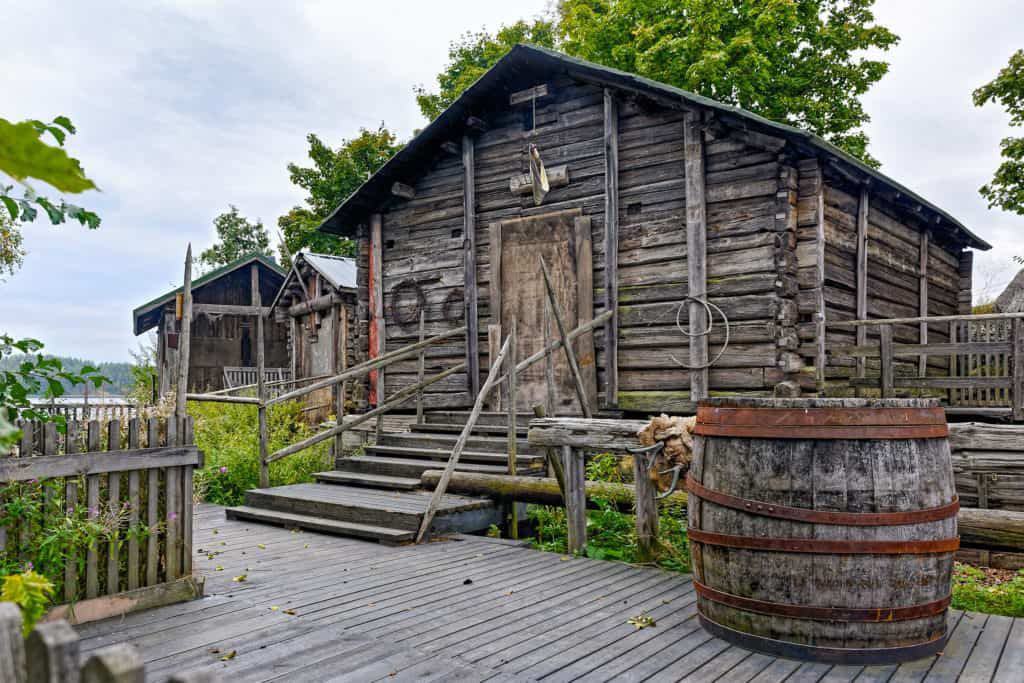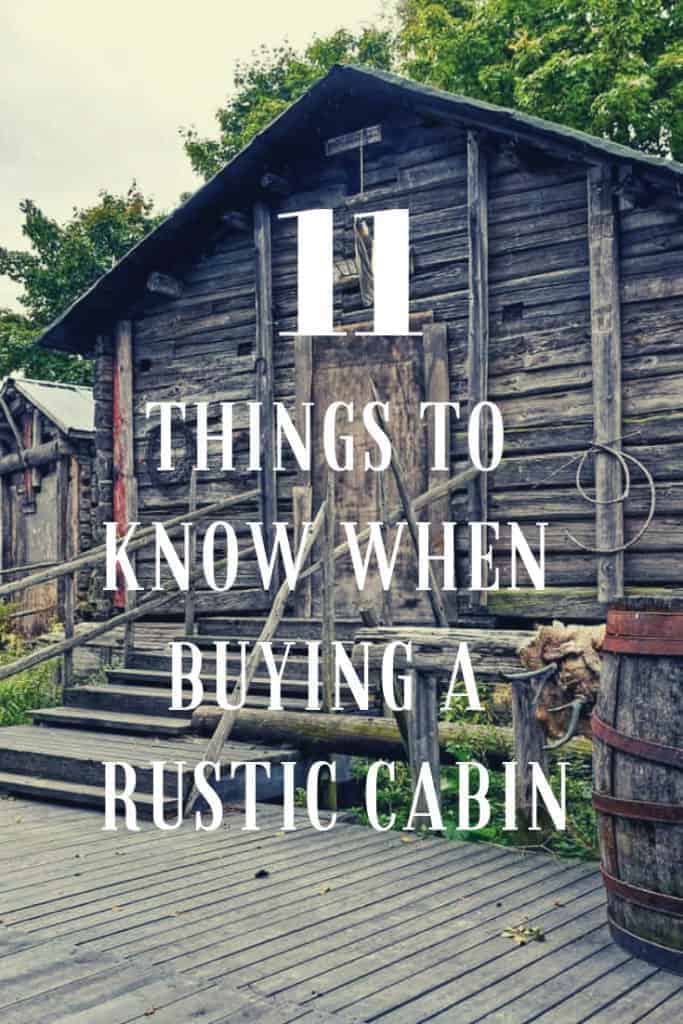
Looking for the right cabin can involve more than a typical house search, especially cheap cabins. I know, after going through that process that there are things I wish I had known about or that I’m glad I did. And so I would like to share 11 things you should look for in a rustic cabin.
- Lay of the Land
- How it was Built
- Current Architecture
- Legality
- Purpose of the Cabin
- Land Worth
- Cabin Worth
- Mortgage
- Winter Access
- Prior Maintenance
- Future Upkeep
The Lay of the Land
Water is the #1 enemy to cabins. Where does the water naturally flow in the property you are interested in? If you notice the property has signs of run-off or looks like a river might flow by or through your property you might want to avoid that spot.
Find out all you can about the existing water patterns, if the property is nearby a body of water, find out the highest recorded water level and the distance from that to your property.
Remember, you can change the cabin but you can’t change the location. I remember hearing of several cabins that were flooded year after year because of spring run-off from melting snow and ice from higher elevations. Eventually, the owners abandoned the property. Don’t let this become you!
This is also true for locations in the desert. Washes, run-off, and flash flood zones should be highly scrutinized when searching for a cabin or potential cabin site. You don’t want to drive out for holiday only to discover the cabin has grown legs and headed down stream.
How was the Cabin Built?
The actual building of the cabin, while not as important as the land it sits on, is still crucial in your decision to buy it. The building must be raised off the ground, meaning the logs shouldn’t touch the ground. This can be either with rocks, concrete, or other materials. If a cabin has its logs on the ground, it paves the way for insects to burrow get into the house as well as moisture to build up and cause cracking in the wood.
The exception to this is if the wood has been properly treated. In addition to asking the last time the wood was treated is to check out the logs for big cracks or signs of rot. Having the wood replaced will create future expenses down the road and should be factored into weighing options.
When was the cabin built? How many owners has the cabin had? Who built the cabin? These questions can sometimes get overlooked despite being at the front of most people’s brains when house hunting. The same caution you would give to a house that has had too many owners in too short a time should also be directed at cabins.
Current Archeticture
The biggest thing to look at is the walls and roof. In its most basic form, a cabin is a shelter from harsh elements that typically are present in cabin-populated areas.
The roof should be overhanging to protect the logs and doorways from the elements like snow and rain.
If the roof doesn’t properly overhang enough, rain may hit a porch and splash back onto the walls. Like we mentioned earlier, water is the cabin’s mortal enemy.
Are there any disclosures that need to be made, specifically on rot, insects and drainage? The roof may have a gutter system, does it work adequately?
Make sure it’s legal!
This advice applies to those who want to build their own rustic cabin to cut costs.
Ask yourself: will the building code in that county allow a rustic cabin? Unfortunately, you can’t just decide to one day go up into the woods and build yourself a cabin. There are codes and laws that everyone has to follow.
While it’s good to listen to the advice of friends who may own cabins, you need to do some research on the county building codes and zoning laws of the specific place you want to build your cabin. These regulations can vary by state or even by county. What may be allowed in one country may be prohibited in the next.
If you do your homework, you’ll be able to avoid any legal issues. The last thing you want is to come under the scrutiny of the local government for building a cabin illegally.
The great thing about some places is there may be zero restrictions or in other words, you can build whatever you want without a permit. Typically this means going off the grid but it helps to learn about the area you want to build in.
The Purpose of the Cabin
What are the needs and wants you have for a cabin? What will be the primary function- a second home, a hunting cabin, a rentable property? Or maybe even something else entirely.
Whatever it may be, consider these things when looking around. If you are planning on having a lot of people staying the night, there may not be many cheap and rustic cabins available.
How much is the land worth?
Does the land match the intended use? If you hope to build a little rustic cabin on a huge and expensive lot, you might want to consider selling the property in exchange for a smaller, more applicable piece of land.
On the other end, if the land has the right location and everything feels perfect but the price is really low, I would question that. Maybe there’s a fundamental issue that I don’t yet see (remember the comments on water problems). Figure out how much the land is worth to you and your plans.
For us, when we purchased the lot with the cabin, we looked to the side lot as a huge potential in developing another cabin. That lot became much more valuable to us in the simple fact alone that it was next to the existing owned cabin. We could be in the first cabin while building the second, a luxary that spoke to us.
How much is the cabin worth?
When looking at cabins, every now and then I came upon a cabin that was unbelievable. The interior workmanship was incredible and the price looked to be deeply low-balled. Those cabins worried me in that there could be something wrong with the property or cabin itself. I questioned the value of the cabin, was there something cheaply done or was the cabin worth what I thought it was.
Checking an official apprasial is great to see if the cabin is worth what you are willing to pay for.
Is the log cabin insured? if so, who with?
Cost goes further than just the land and cabin. If you live far away or have a boat that you’ll use at a lake by the cabin, you should factor commuting costs and boat fuel costs. After doing the finances, are you prepared for this big decision?
Get a Mortgage Approval
I won’t lie, it’s fun to check out really nice houses or cabins well above our budget and think, “what if”. That’s what the parade of homes is for right? However, the fun and games can go too far if you actually buy something you can’t afford. It will save you time to focus in on your target price range when looking at cabins. Especially since the list of ideal cabins that meet your needs may be far from each other.
Go to a financial institution such as a credit union or bank and find out what specific price range of cabins you could qualify for a loan or mortgage. This is important to keep in mind before you sign up for something you definitely cannot afford.
Stay within your means and you can enjoy the cabin for years to come.
Is the Location the Best for My Needs?
If you think there might be a better place for the cabin, why not just get a different lot?
Would it make more sense to just build a hunting cabin on a better lot?
What is Winter Access to the Property Like? Plowed? Snow machine?
You wouldn’t want to go for a weekend getaway one winter only to be snowed in for weeks. I’ve known other cabin owners to recount such stories including some friends who were trapped in their cabin for a solid week before help arrived on snowmobiles.
It can be hard to comprehend if you haven’t been in a huge snowstorm but a few feet of snow can become nearly impossible to navigate when unplowed for miles in less populated areas.
Some private cabin communities pay for plowing services up to each property while others must fend for themselves when the snow flurries fly. You’ll want to learn what the plan is for the area surrounding a potential cabin and make a plan for your own cabin in the event that access becomes limited.
Maintenance of the Cabin
How well did the previous owners take care of the cabin and the surrounding property?
There are several things you can check besides just the general upkeep inside the cabin. If the cabin is the rustic kind with chinking in between logs, check to see if there are cracks in the chinks or even missing sections altogether. This is a possible sign of neglect as those types of cabins must be re-chinked often to avoid cracking.
Most cabins also stain the wood to protect it and increase the longevity of the wood. Ask when the last time the cabin was stained as well as chinked. Knowing this will help in the decision process as both could become added costs for you.
Future Upkeep
Will the property need routine check-ins to make sure no problems arise or can you let the place sit for long stretches of time?
If the purpose of the cabin is to rent it out to other vacationers, you may need to consider a few factors. Your distance from your primary residence to the cabin as well as the frequency of renters may be something to look at for possibility of hiring a cleaner to help.
Think about how much time it takes to maintain your current residence and then tack on the clean time of a cabin onto that. While cabins typically are more relaxed than your average house, it can still add up time. Be realistic on what you can and can’t do.
Related Questions
Should we pay for a home inspector? Since looking for cabins can take you far and wide it may be wise to wait until once you have narrowed down the market to a couple of options. Then I would suggest paying for a home inspector to check them out.
Do I need to build on the property right away? Some land agreements require that lots are developed within a certain time of ownership. Find out what would all be in your agreement and get it in writing.

